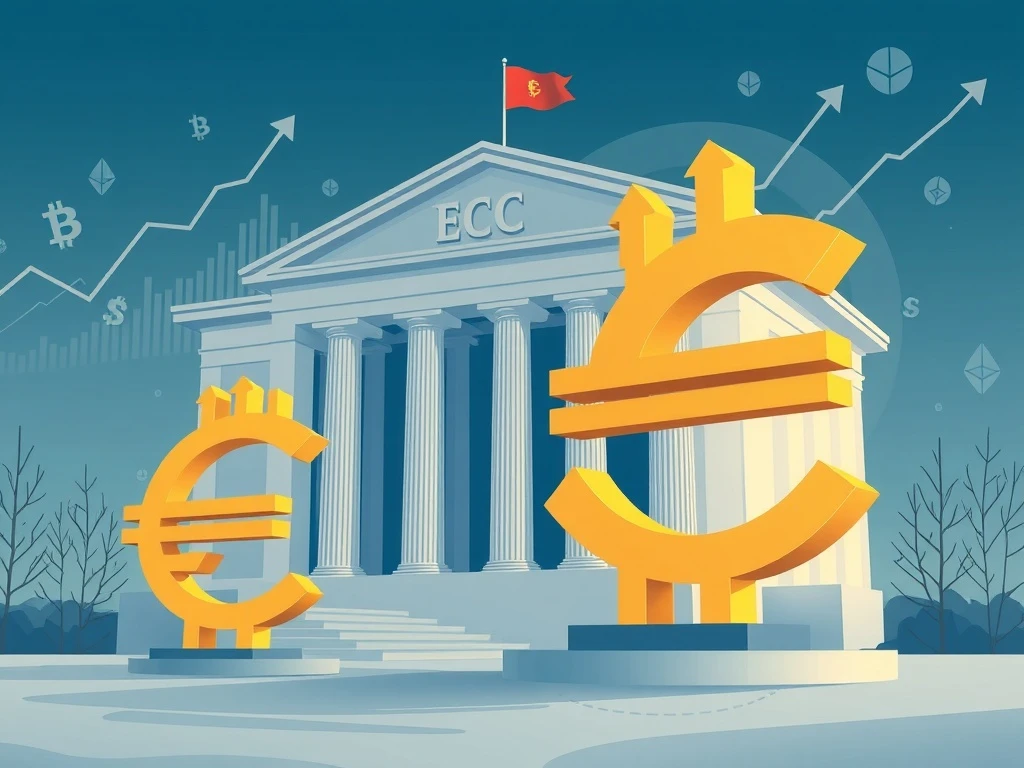ECB Interest Rates: A Crucial Strategic Pause for Eurozone Stability

For cryptocurrency enthusiasts, every major central bank decision ripples across the global financial landscape, and the recent move by the European Central Bank (ECB) is no exception. While not directly linked to digital assets, the ECB’s strategic decision regarding ECB interest rates holds significant implications that can subtly shape investor sentiment and capital flows, ultimately influencing the broader crypto market. So, what exactly did the ECB do, and why should you, as a crypto investor, pay attention?
ECB Interest Rates: A Strategic Pause Amidst Global Uncertainty
The European Central Bank (ECB) has made a pivotal decision, opting to keep its key interest rates unchanged. This means the deposit rate remains at 2%, the main refinancing rate at 2.15%, and the marginal lending rate at 2.40%. This marks a significant shift from a previous series of seven consecutive rate cuts, signaling a period of cautious assessment rather than aggressive stimulus.
This pause is a deliberate move by the ECB to:
- Evaluate Past Actions: Assess the full impact of previous rate adjustments on inflation, economic growth, and financial stability.
- Navigate Global Risks: Account for ongoing global uncertainties, including geopolitical tensions and persistent supply chain disruptions.
- Balance Mandates: Uphold its dual mandate of maintaining price stability while also supporting economic activity.
By holding rates steady, the central bank aims to ensure that its prior interventions do not inadvertently reignite inflationary pressures or destabilize financial markets. It’s a data-driven approach, emphasizing stability in a complex economic environment for ECB interest rates.
Navigating the Eurozone Economy: Predictability vs. Growth Stimulus
For the broader Eurozone economy, stable interest rates offer a degree of predictability. Businesses and consumers can better anticipate borrowing costs, which generally supports spending and investment decisions. This stability helps avoid abrupt market shocks that could otherwise derail economic recovery. However, this stability comes with its own considerations:
- Predictable Borrowing Costs: Offers clarity for businesses planning investments and consumers managing debt.
- Support for Spending: Encourages consumer and business spending by maintaining stable financing conditions.
- Limited Growth Stimulus: The absence of further rate cuts means less direct monetary stimulus, which could limit growth, especially in sectors that thrive on expansionary policies.
The ECB’s focus is on ensuring a controlled environment for the Eurozone to adapt to evolving conditions, balancing the need for stability with the potential for slower growth in specific areas of the Eurozone economy.
The Evolving Landscape of Monetary Policy: What’s Next for the ECB?
The ECB’s current stance reflects a shift in its monetary policy strategy. After a period of aggressive easing, the central bank is now in an observational phase, closely monitoring key economic indicators. This includes analyzing persistent core inflation, which remains above the ECB’s target of “below but close to 2%,” and assessing the lagged effects of its prior rate cuts on overall economic activity.
Key challenges for the ECB’s future monetary policy include:
- Sticky Inflation: Managing inflationary pressures that prove more persistent than anticipated.
- Recession Risks: Evaluating the potential for economic downturns in various Eurozone member states.
- Geopolitical Uncertainties: Responding to unforeseen global events that could impact energy prices and supply chains.
- Divergent Fiscal Policies: Addressing the complexities arising from different fiscal approaches among Eurozone nations, which can complicate a unified monetary policy strategy.
Investors will need to pay close attention to incoming data, as future policy shifts will depend heavily on these evolving macroeconomic signals.
Understanding the Inflation Outlook and Global Headwinds
A primary driver behind the ECB’s pause is the ongoing assessment of the inflation outlook. While headline inflation may show signs of cooling, core inflation – which excludes volatile energy and food prices – remains a concern. The central bank is keen to ensure that underlying price pressures are genuinely receding towards its target.
Globally, several headwinds continue to influence this outlook:
- Energy Price Volatility: Fluctuations in global energy markets can quickly impact consumer prices and business costs.
- Uneven Recovery: Different Eurozone member states are experiencing varying paces of economic recovery, creating a complex picture for a unified monetary approach.
- Global Economic Slowdown: Broader global economic trends can influence demand for Eurozone exports and overall economic sentiment.
The ECB’s cautious approach aims to prevent premature tightening or loosening that could disrupt the delicate balance required to bring inflation sustainably to target, thus shaping the overall inflation outlook.
How the ECB’s Decision May Influence Crypto Market Reaction
While the ECB doesn’t directly regulate cryptocurrencies, its decisions on conventional monetary policy can have an indirect yet noticeable crypto market reaction. A stable Eurozone, with predictable interest rates, can contrast with potential rate cuts or shifts by other major central banks, such as the U.S. Federal Reserve. This divergence can lead to:
- Currency Dynamics: A stronger euro against the U.S. dollar, as investors might find Eurozone assets relatively more appealing. This could impact trade balances and capital allocations globally.
- Investment Flows: Eurozone bonds and fixed-income assets may gain relative appeal, potentially drawing some capital away from riskier assets, including cryptocurrencies, or signaling a general shift towards stability.
- Bitcoin as a Hedge: A stronger euro could reduce the immediate demand for the U.S. dollar. Since Bitcoin is often seen as a hedge against fiat depreciation, particularly the dollar, a weaker dollar could theoretically influence Bitcoin’s performance. However, this is a complex interplay of many factors.
- Broader Investor Sentiment: The overall stability or instability signaled by major central banks influences general investor confidence, which can spill over into the highly speculative crypto markets, leading to a noticeable crypto market reaction.
For crypto investors, this underscores the importance of monitoring broader macroeconomic indicators and understanding how traditional financial policies can create ripple effects in the digital asset space. Portfolio diversification and a keen eye on global capital flows remain crucial strategies.
Conclusion: A Cautious Path to Stability
The European Central Bank’s decision to hold key interest rates steady reflects a cautious, data-driven approach amidst a complex and evolving economic landscape. By prioritizing stability over immediate intervention, the central bank aims to foster a controlled environment for the Eurozone to adapt to shifting global and domestic conditions. For investors across all asset classes, including cryptocurrencies, this signals a period where macroeconomic data will be paramount in shaping future policy expectations. The next steps in the ECB’s monetary strategy will hinge on how inflation evolves, how the Eurozone economy responds, and how global risks play out. Staying informed is key to navigating these financial currents.
Frequently Asked Questions (FAQs)
Q1: Why did the ECB decide to maintain its interest rates at 2%?
A1: The ECB chose to maintain its key interest rates to assess the full impact of previous rate cuts on inflation, economic growth, and financial stability. This strategic pause allows them to navigate global uncertainties like geopolitical tensions and supply chain disruptions, ensuring price stability without inadvertently reigniting inflation or destabilizing markets.
Q2: How do stable ECB interest rates affect the Eurozone economy?
A2: Stable rates provide predictability for borrowing costs, which generally supports consumer and business spending. While this avoids abrupt market shocks and fosters a stable environment, the lack of further cuts may limit direct stimulus for economic growth, particularly in sectors that rely on expansionary monetary policy.
Q3: What are the main challenges facing the ECB’s monetary policy going forward?
A3: The ECB faces several challenges, including managing persistent core inflation, assessing potential recession risks across Eurozone nations, and addressing ongoing geopolitical uncertainties. Additionally, divergent fiscal policies among Eurozone countries complicate the implementation of a unified monetary strategy.
Q4: How might the ECB’s decision indirectly impact cryptocurrency markets?
A4: The ECB’s stable stance can influence currency dynamics, potentially strengthening the euro against the dollar if other central banks cut rates. A stronger euro could reduce dollar demand, which might indirectly influence Bitcoin’s performance as a hedge. More broadly, central bank decisions shape investor sentiment, affecting capital flows into various asset classes, including crypto.
Q5: What should investors monitor following the ECB’s rate decision?
A5: Investors should closely monitor incoming economic signals, particularly data related to inflation (especially core inflation), economic growth indicators, and employment figures. Global developments, such as energy price volatility and geopolitical events, will also be crucial in anticipating the ECB’s next moves and adjusting investment strategies accordingly.







